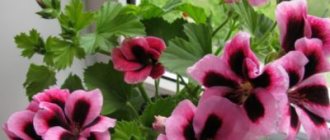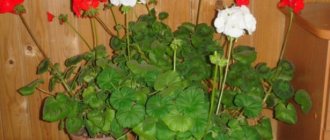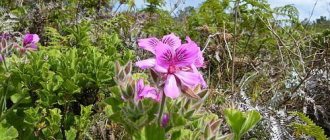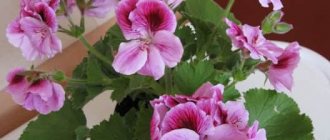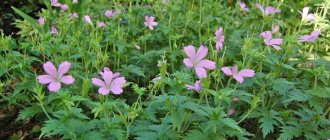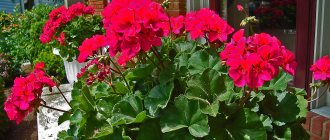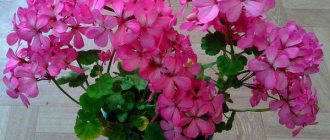Instagram VK
Tel. 8-996-686-71-22 (VIBER, WhatsApp). Email: [email protected]
Cvetovod86 cuttings and flower seedlings
Search
Cart / 0 ₽ 0
Cvetovod86 cuttings and flower seedlings
Instagram VK
Cart / 0 ₽ 0
350 ₽
Royal Pelargonium 'Rimfire'.-rooted cuttings
SKU: 3093 Category: pelargonium Tags: Royal pelargonium 'Rimfire'., Royal pelargonium 'Rimfire'. stalk
- Description
- Reviews (0)
Royal or large-flowered pelargonium. Forms well and responds well to pinching. Vertical growth. The leaf is green, lobed, may be serrated, and is often covered with hairs. The bush forms a head of large flowers (up to 10 cm in diameter). Wintering is required at a temperature of 10-15 degrees, for 1.5-2 months, otherwise flowering will be sparse or not at all.
Royal Pelargonium 'Rimfire' - rich burgundy, almost black petals with a fiery red border.
Diseases and pests
Pelargoniums rarely get sick and mainly due to improper care. If fungal diseases such as leaf rust or blackleg are detected, the plants are treated with fungicides.
During treatment you need:
- Remove all inflorescences so that the plant does not waste its energy on them;
- Support it with the immunostimulants Zircon or Epin, adding 7-8 drops of the product per 500 ml of water with complex fertilizer dissolved in it;
- Limit watering, eliminate high humidity;
- Ensure good lighting and no drafts.
Indoor geraniums can also be bothered by insect pests - whiteflies, mites, caterpillars, aphids. Their presence is easily detected by careful examination of the leaves.
Aphids on pelargonium leaves
Get rid of them with insecticidal agents. You can use specific ones based on the type of pest or complex ones.
But much more often, flower growers themselves become the culprits of pelargonium disease by not following the rules of care. For example, if the leaves of a plant begin to turn yellow and dry around the edges, this indicates a clear lack of moisture.
The plant does not have enough water
Droopy foliage throughout the bush, on the contrary, signals that the frequency of watering should be reduced. And if the lower leaves begin to fall, you need to increase the lighting.
Growing pelargonium
Indoor geranium is grown not only as an ornamental, but also as a very useful plant:
- It cleanses the air of bacteria, and its smell improves mood and relieves stress;
- Plants standing next to pelargonium rarely suffer from pests;
- Its fresh leaves help treat ulcers; they are tied to wounds to heal them as quickly as possible. A decoction of the leaves helps with pain in the stomach and intestines.
This plant is used not only in folk medicine, but also in traditional medicine, cosmetology, and aromatherapy. An essential oil is obtained from it, which helps with back and muscle pain, runny nose and otitis media.
Geranium essential oil
If it is not possible to purchase an adult bush, you can grow pelargonium from seeds or cuttings. The plant is not afraid of pruning and tolerates it easily, so you can break off a branch and root it at home without harming it.
Growing from seeds
Buying seeds of any variety is not a problem. The choice is huge. But from “their” seeds it is unlikely that a plant will grow with all the characteristics of the mother variety. But you can try, only the seeds need to be scarified before planting - remove the hard outer shell by rubbing them between two sheets of fine sandpaper.
Pelargonium zonalis seeds
Purchased seeds do not need such treatment. Planting them is also easy. This is done at the end of February so that the pelargonium has time to bloom in the same summer.
- Since the seeds are large, they can be immediately laid out one at a time at a distance of 2-3 cm from one another, laying the flat side on damp soil and pressing slightly. No need to sprinkle on top.
Sowing seeds in seedling containers
- After planting, the soil is sprayed. It is better to use a spray bottle rather than a watering can, so as not to wash away the seeds from their places.
- Then the planting boxes are covered with glass or film and put away in a warm and dark place.
- They are ventilated, sprayed and monitored for germination every day.
After 5-7 days, the first shoots appear. From this point on, the glass is removed, the boxes are exposed to light and the seedlings are periodically watered, being careful not to flood them or get them on the leaves.
After four true leaves appear, the seedlings are planted in separate cups or flower pots.
Seedlings are a few days old
Grown seedlings
Planted plants quickly begin to grow
Pelargoniums grown from seeds bloom five months after germination.
This is interesting. Geranium and pelargonium were combined into one family because of the same fruit capsule with seeds. An elongated pestle sticks out of it, and together they resemble the head of a stork or a crane with a long beak. Hence the names, because “Geranium” translated from Greek means crane, and “Pelargos” means stork.
Pelargonium fruit pods
Growing from cuttings
Cuttings allow you to preserve the characteristic varietal characteristics of the plant you like. Any parts of shoots with buds are suitable for this. They are cut into pieces 6-8 cm long and placed in water for root germination.
Leaves are torn off from the bottom of the cuttings
To avoid confusing varieties, germinate cuttings in different containers
Sprouted cuttings
Seedlings with young white roots are planted in prepared soil in a permanent pot. It must have drainage holes. Size is not particularly important - pelargonium does not require a large volume, so young seedlings can be placed in a small pot with a diameter of about 15 cm, and they will live well in it for two years.
Preference should be given to ceramic containers. The soil in them dries out faster than in plastic ones, and pelargonium does not like stagnant moisture.
Fired clay pot
For the same reason, you cannot do without a drainage layer at the bottom at least 2-3 cm thick.
As for the soil, you can use any universal soil mixture for indoor plants. If you decide to take soil from the garden, then it needs to be mixed with peat, sand and vermiculite to make it light and loose.
Any universal soil is suitable for growing pelargoniums.
Cuttings of pelargoniums bloom three months after rooting. The only exceptions are violet and royal varieties. Regardless of the growing method, their flowering occurs only in the second year.
Rules of care
Pelargonium is one of the most unpretentious houseplants. Caring for her is easy and pleasant.
You just need to follow some simple rules:
- Water only when the top layer of soil dries out. It is better to skip watering than to allow excess moisture, as the plant does not like it. As well as water getting on leaves and flowers. Therefore, there is no need to spray it, and if the air is excessively dry, it is better to place bowls of water next to it.
Pelargonium cannot be poured or sprayed
- Indoor geranium loves light very much and develops and blooms poorly when there is a lack of it. Therefore, it needs to be grown in well-lit windows.
Pelargonium is a light-loving plant
- Pelargonium is undemanding to air temperature, especially in summer. In winter, during the dormant period, it is enough to maintain it at least 10 degrees and protect the plant from drafts.
In summer, indoor geranium feels great outdoors; it can be planted directly into the ground.
- But the soil in which the flower “lives” must be loose so that air can flow freely to the roots. Therefore, it needs to be loosened periodically, preventing it from turning into a dense lump.
Loose soil is a prerequisite for the well-being of pelargoniums
- You need to feed the plant only before and during flowering, using phosphorus fertilizers.
Special fertilizers for petunias and pelargoniums
Note! The plant does not tolerate organic fertilizers, and when there is an excess of nitrogen, it refuses to bloom, gaining only green mass.
In general, caring for pelargonium largely depends on the season. To avoid any confusion, keep this sign for yourself:
| Period | Watering | Lighting | Temperature | Top dressing |
| Spring – early autumn | Water when the top layer of soil dries out | Bright light for 12-14 hours. If there is insufficient light, add additional light. Keep away from direct sunlight. | Any, optimally from 22 to 27 degrees. In extreme heat, humidify the air. | No more than 3 times a month with fertilizers for flowering plants. |
| Late autumn - winter | Water only after the soil is completely dry | Keep in a bright place, without additional lighting. | Optimally 10-15 degrees. | Do not feed. |
In order for the bushes to be beautiful and lush, they need to be shaped. Adult plants are pruned in the fall, leaving no more than five buds on each “stump.” New young shoots will grow from them. If there is only one branch, you can leave 6-7 buds.
Don't be afraid to trim the bushes, it will only benefit them
Advice. Do not water the plant before pruning to prevent moisture from escaping through the fresh cuts.
In early spring, if the shoots have become too long over the winter, they can be pruned or pinched again. Pinching is also done on young plants.
When more than five leaves form on a branch, its top above the bud is carefully plucked off or cut off. But this must be done before flowering, or better at the very end of winter or early spring.
Trimming scheme
There is no need to replant pelargonium every year. This can be done once every 2-3 years, when it slows down its growth, choosing a pot a little larger than before.
Try to replant without exposing the roots of the plant.
